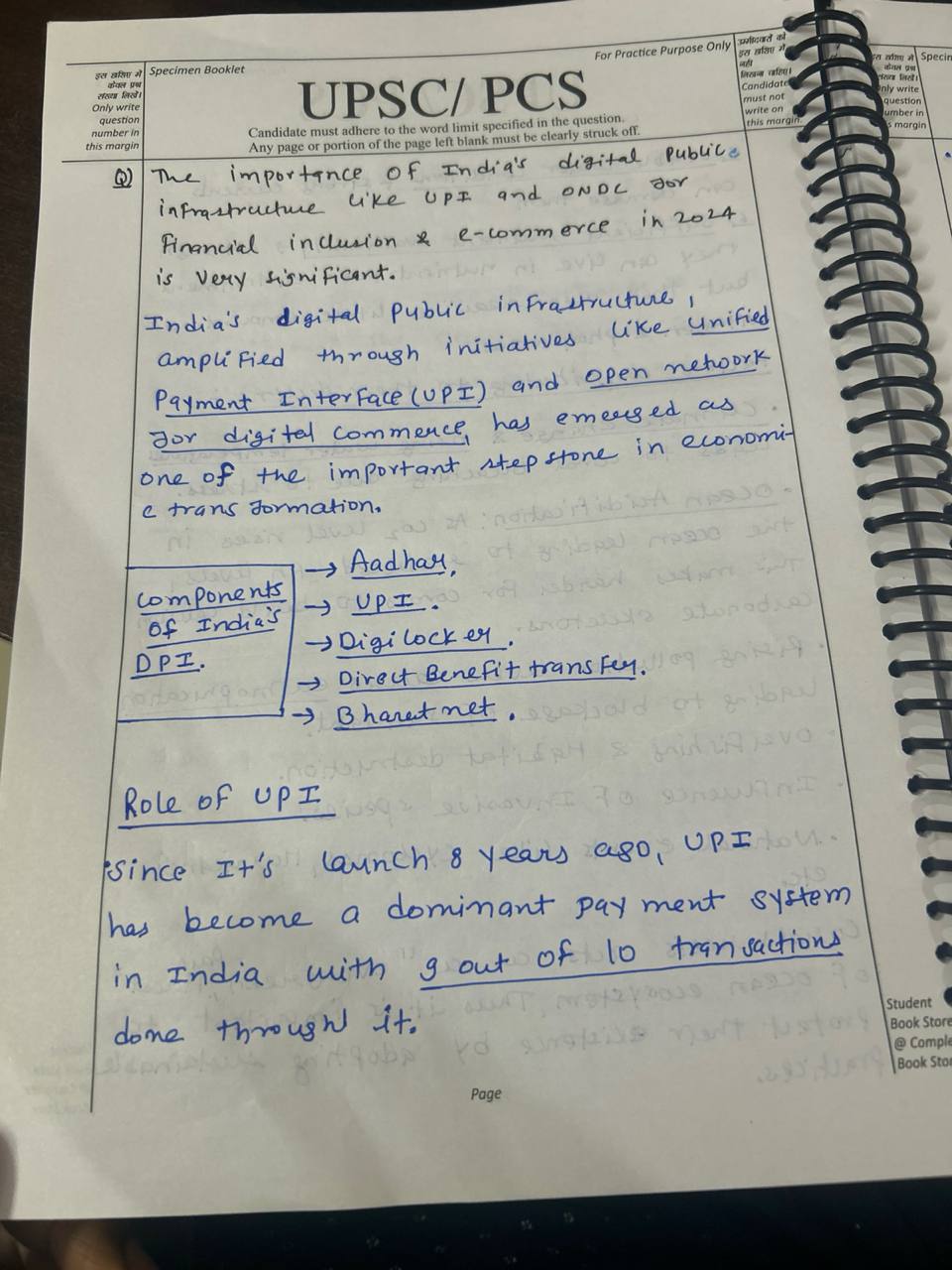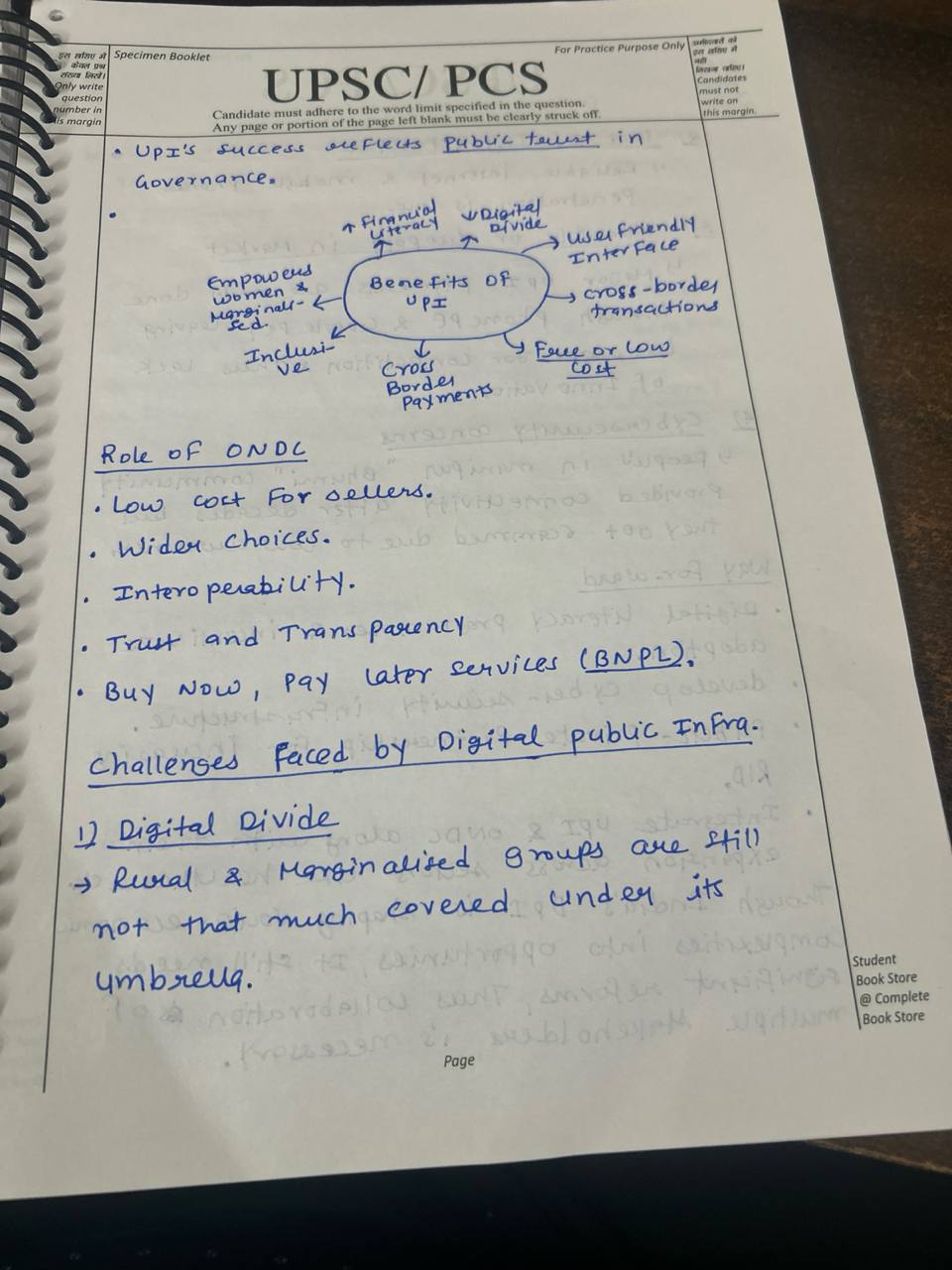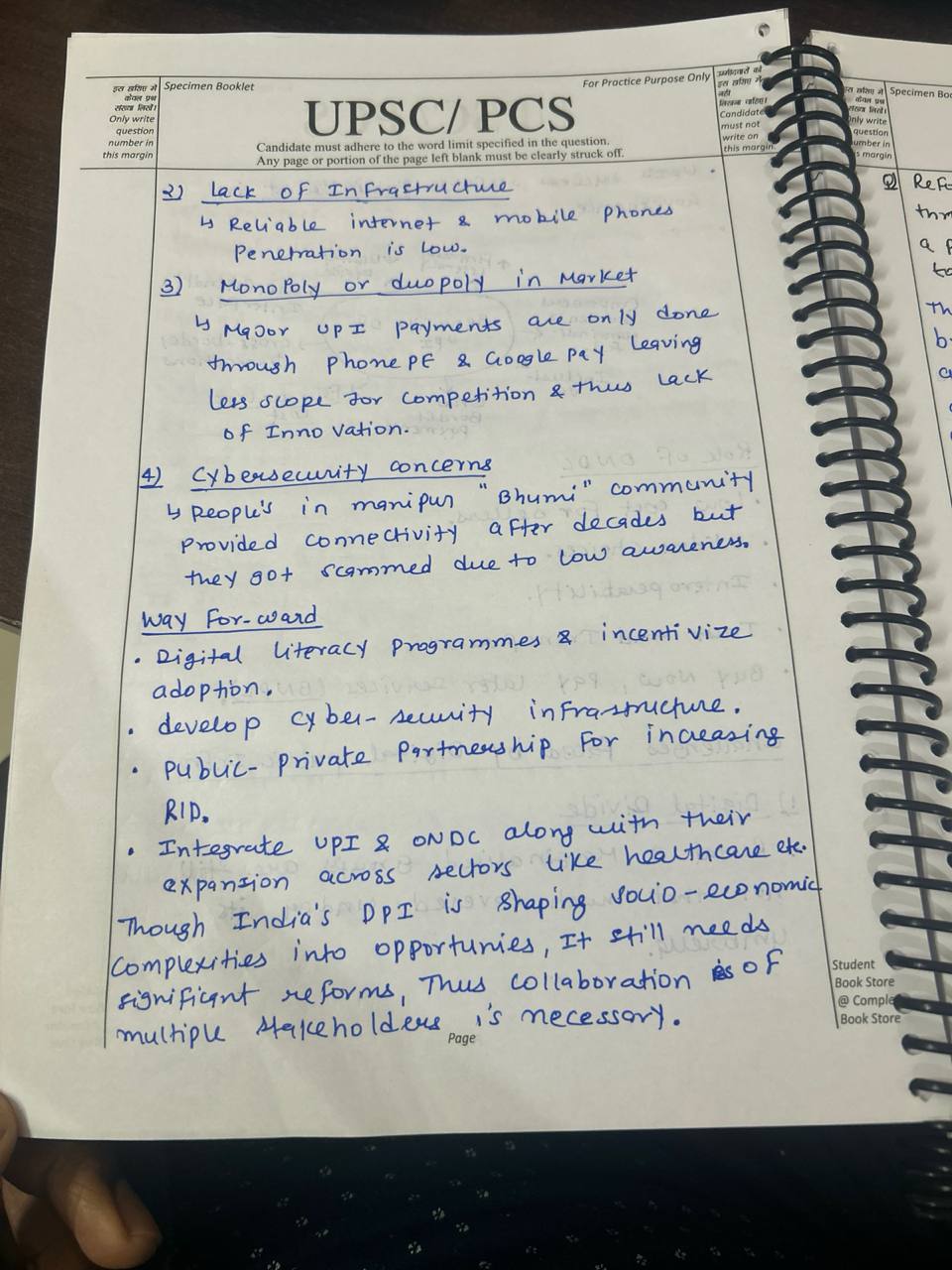Home/Probity in Governance/Transparency in Government: Right to Information, Citizen’s Charters
Transparency in Government: Right to Information, Citizen’s Charters
Share
294 Followers
34 Answers
21 Questions
Resources & Suggestions
Mains Answer Writing Latest Articles
On: February 22, 2025
Comments:
0
Indo-US Relation: Areas of Cooperation & Conflicts
Key Areas: Defense, technology, trade, energy, and regional cooperation. Key Areas of Cooperation 1. Defense and Security Transition from buyer-seller to co-production and technology sharing. India as a Major Defense Partner (MDP) and inclusion in STA-1. Access to advanced technologies, ...
On: February 22, 2025
Comments:
0
भारत-अमेरिका संबंध: सहयोग और संघर्ष के क्षेत्र
मुख्य विषय: भारत-अमेरिका संबंधों की मजबूती, विशेषकर रक्षा, प्रौद्योगिकी और क्षेत्रीय सहयोग में प्रगति। सहयोग के प्रमुख क्षेत्र 1. रक्षा एवं सुरक्षा सहयोग भारत और अमेरिका के बीच रक्षा संबंधों का विस्तार। प्रमुख रक्षा साझेदार (MDP) का दर्जा और STA-1 ...
On: February 22, 2025
Comments:
0
India’s Disaster Management
The article discusses the growing tensions between the Centre and states regarding disaster relief funding in India. It emphasizes the need for a transparent and equitable disaster management framework. Key Disaster Threats India Faces Increasing Frequency of Extreme Weather Events ...

How do citizen charters, which are primarily designed to empower and inform citizens, also provide various advantages for the bureaucracy? Discuss.(200 Words)
Model Answer Empowering Through Information Citizen charters enhance transparency by clearly outlining the services available, which empowers citizens to access these services effectively. By specifying rights and entitlements, they enable citizens to hold government agencies accountable for timelyRead more
Model Answer
Empowering Through Information
Citizen charters enhance transparency by clearly outlining the services available, which empowers citizens to access these services effectively. By specifying rights and entitlements, they enable citizens to hold government agencies accountable for timely service delivery.
Standardization of Procedures
One of the key benefits of citizen charters for the bureaucracy is the standardization of procedures. By clearly defining service procedures and timelines, citizen charters help streamline operations. This reduces processing times and minimizes confusion, which improves service accuracy and decreases the need for rework.
Performance Benchmarking
Citizen charters establish specific service standards, allowing bureaucrats to benchmark their performance. This facilitates self-assessment and highlights areas for improvement, fostering a culture of accountability within the administration .
Increased Public Trust
By promoting transparency and accountability, citizen charters enhance trust between citizens and bureaucrats. This not only reduces grievances but also cultivates a positive image of the bureaucracy. When citizens feel heard and valued, it leads to a more cooperative relationship.
Improved Morale and Motivation
The visibility of their impact on citizens can lead to higher job satisfaction among bureaucrats. Citizen charters can also serve as a platform to recognize and reward those who consistently provide high-quality services, boosting morale and motivation within the workforce.
Conclusion: Service Improvement
Feedback mechanisms included in citizen charters allow for data collection that informs service improvement initiatives. This data-driven approach enables bureaucracies to adapt and respond more effectively to the needs of citizens, ultimately enhancing service quality.
In summary, while citizen charters are designed to empower citizens, they also offer numerous benefits to the bureaucracy, fostering a more efficient, accountable, and motivated administrative system.
See less"Access to information is a fundamental public right. In this regard, what are the key principles that should govern the sharing of information by the government?"(200 Words)
Model Answer Introduction Access to information is a fundamental human right, recognized under Article 19 of the Universal Declaration of Human Rights (1948). Governments are expected to ensure transparency and accountability in their dealings by providing citizens with access to public information.Read more
Model Answer
Introduction
Access to information is a fundamental human right, recognized under Article 19 of the Universal Declaration of Human Rights (1948). Governments are expected to ensure transparency and accountability in their dealings by providing citizens with access to public information. This principle is foundational for democracy and the protection of freedoms.
Key Principles for Information Sharing by the Government:
Conclusion
The above principles provide a framework for ensuring transparency, accountability, and inclusiveness in government functioning. By adhering to these principles, governments can build greater public trust, improve governance, and empower citizens to participate actively in democratic processes.
See lessONDC



See less"The Right to Information Act is not all about citizens' empowerment alone, it essentially redefines the concept of accountability." Discuss. (150 words) [UPSC 2018]
The Right to Information Act and Accountability Redefining Accountability Citizens' Empowerment: While the Right to Information (RTI) Act empowers citizens by providing them access to information held by public authorities, its impact extends beyond individual empowerment. It fundamentally redefinesRead more
The Right to Information Act and Accountability
Redefining Accountability
Citizens’ Empowerment: While the Right to Information (RTI) Act empowers citizens by providing them access to information held by public authorities, its impact extends beyond individual empowerment. It fundamentally redefines accountability in governance.
Enhanced Transparency: The RTI Act mandates that government actions and decisions be transparent. This transparency compels public officials to be more accountable for their actions. Example: In recent years, RTI applications have uncovered issues like irregularities in public distribution systems and misuse of funds in various schemes, leading to corrective actions.
Systematic Oversight: The Act enables systematic oversight by allowing citizens to request information and hold public bodies accountable. It ensures that officials must justify their decisions and actions, fostering a culture of responsibility. Example: Investigations triggered by RTI queries have led to exposing corruption in construction projects and mismanagement in educational institutions.
Conclusion: The RTI Act not only empowers citizens but also redefines accountability by ensuring transparency, encouraging responsible governance, and facilitating public oversight.
See lessThere is a view that the Official Secrets Act is an obstacle to the implementation of Right to Information Act. Do you agree with the view? Discuss.(150 words) [UPSC 2019
Official Secrets Act and Right to Information Act Agreement with the View: **1. Official Secrets Act and Its Impact a. Purpose and Limitations: The Official Secrets Act (OSA) of 1923 aims to protect sensitive government information related to national security and public safety. It restricts the disRead more
Official Secrets Act and Right to Information Act
Agreement with the View:
**1. Official Secrets Act and Its Impact
a. Purpose and Limitations:
The Official Secrets Act (OSA) of 1923 aims to protect sensitive government information related to national security and public safety. It restricts the disclosure of information deemed confidential, which can conflict with the principles of transparency and accountability promoted by the Right to Information Act (RTI) 2005.
b. Obstacle to Transparency:
The OSA can limit the scope of information accessible under RTI, thereby hindering the public’s right to know. For instance, in 2020, the Delhi High Court found that certain information withheld under the OSA was not directly related to national security and should be disclosed under RTI.
**2. Discussion and Recent Examples
a. Balancing Act:
While the OSA is essential for safeguarding national interests, it sometimes conflicts with the RTI Act’s goals. For example, the RTI application seeking details on the Rafale aircraft deal faced delays and denials based on the OSA, raising concerns about its overreach.
b. Recent Case:
In 2021, the Supreme Court ruled that information about the appointment of officials under the OSA should be provided if it does not compromise national security, illustrating the need for a balanced approach between secrecy and transparency.
Conclusion:
See lessYes, the Official Secrets Act can act as an obstacle to the effective implementation of the Right to Information Act. Ensuring a balance between national security and transparency is crucial for maintaining public trust and accountability.
Explain the basic principles of citizens charter movement and bring out its importance.(150 words) [UPSC 2019]
Principles of the Citizens' Charter Movement Citizens' Charter is a concept aimed at enhancing public service delivery by setting clear standards of service and ensuring accountability in governance. The basic principles of this movement include: Transparency: Public services should clearly communicRead more
Principles of the Citizens’ Charter Movement
Citizens’ Charter is a concept aimed at enhancing public service delivery by setting clear standards of service and ensuring accountability in governance. The basic principles of this movement include:
Importance
The Citizens’ Charter movement is crucial as it:
Conclusion
The Citizens’ Charter movement, through its principles of transparency, accountability, participation, and redressal, plays a pivotal role in improving public service delivery and fostering trust between citizens and government.
See lessDiscuss the role of 'Right to Information' for transparency in governance. (125 Words) [UPPSC 2020]
Role of 'Right to Information' (RTI) in Transparency in Governance 1. Enhancing Transparency: Right to Information (RTI) Act, 2005, empowers citizens to seek information from public authorities, thus promoting transparency in government operations. For instance, the RTI request revealed irregularitiRead more
Role of ‘Right to Information’ (RTI) in Transparency in Governance
1. Enhancing Transparency: Right to Information (RTI) Act, 2005, empowers citizens to seek information from public authorities, thus promoting transparency in government operations. For instance, the RTI request revealed irregularities in the implementation of the Pradhan Mantri Awas Yojana (PMAY) in various states.
2. Accountability: RTI holds public officials accountable by making government decisions and fund utilization open to scrutiny. Recent RTI disclosures about COVID-19 relief funds highlighted discrepancies in fund allocation and usage.
3. Public Participation: By enabling citizens to access information, RTI fosters active public participation in governance. For example, RTI applications have been used to track environmental clearance processes for major projects.
Conclusion: RTI plays a crucial role in enhancing transparency, accountability, and public engagement in governance, leading to more effective and open administration.
See less"Concealment of Information impedes public access and involvement". In the light of this statement discuss the importance of information sharing and transparency in Government. (125 Words) [UPPSC 2023]
Importance of Information Sharing and Transparency in Government Enhanced Public Participation Informed Decision-Making: Transparency ensures that citizens have access to critical information, enabling them to make informed decisions and participate actively in governance. For instance, the RTI ActRead more
Importance of Information Sharing and Transparency in Government
Enhanced Public Participation
Prevention of Corruption
In summary, information sharing and transparency are vital for fostering public participation, building trust, preventing corruption, and ensuring effective governance.
See lesssystem of climate change
Transitioning to a low-carbon economy presents several challenges: Economic Costs: The shift involves significant upfront investments in green technologies and infrastructure, which can be a financial burden for businesses and governments. There is also the potential for economic disruption as indusRead more
Transitioning to a low-carbon economy presents several challenges:
Overall, overcoming these challenges requires coordinated efforts between governments, businesses, and communities to ensure a smooth and equitable transition to a low-carbon economy.
See lessEthical Challenges in Implementing Transparent Data Practices
Transparent data practices, where users understand how their information is collected and used, are crucial in today's data-driven world. However, implementing them ethically presents several challenges: Balancing Transparency with Privacy: Data Security: Increased transparency can expose data, makiRead more
Transparent data practices, where users understand how their information is collected and used, are crucial in today’s data-driven world. However, implementing them ethically presents several challenges:
Balancing Transparency with Privacy:
User Comprehension and Control:
Algorithmic Bias and Fairness:
Additional Challenges:
Conclusion:
Transparent data practices are a worthy goal, but ethical considerations require careful navigation. By addressing these challenges, organizations can build trust with users and ensure responsible data collection and utilization.